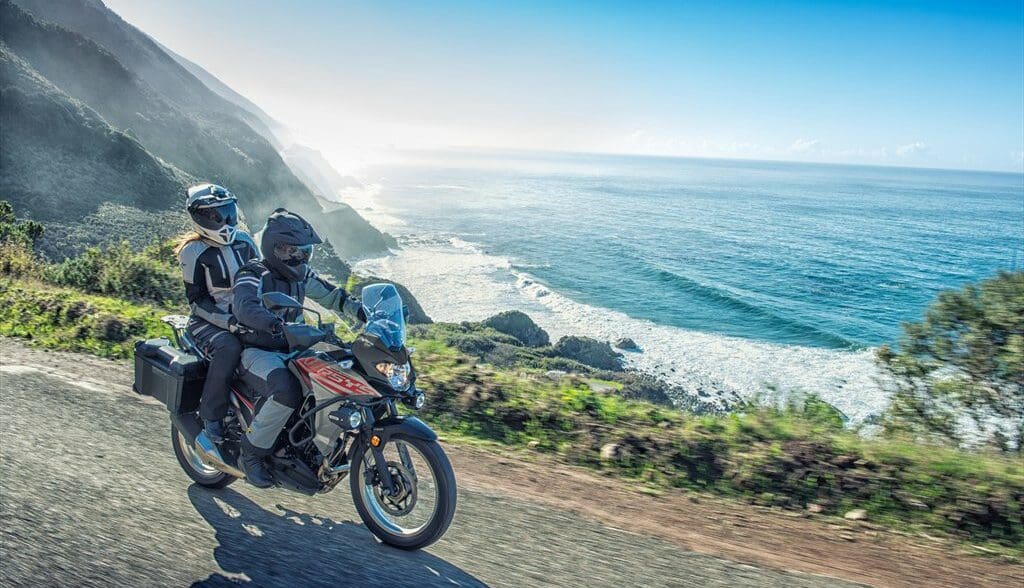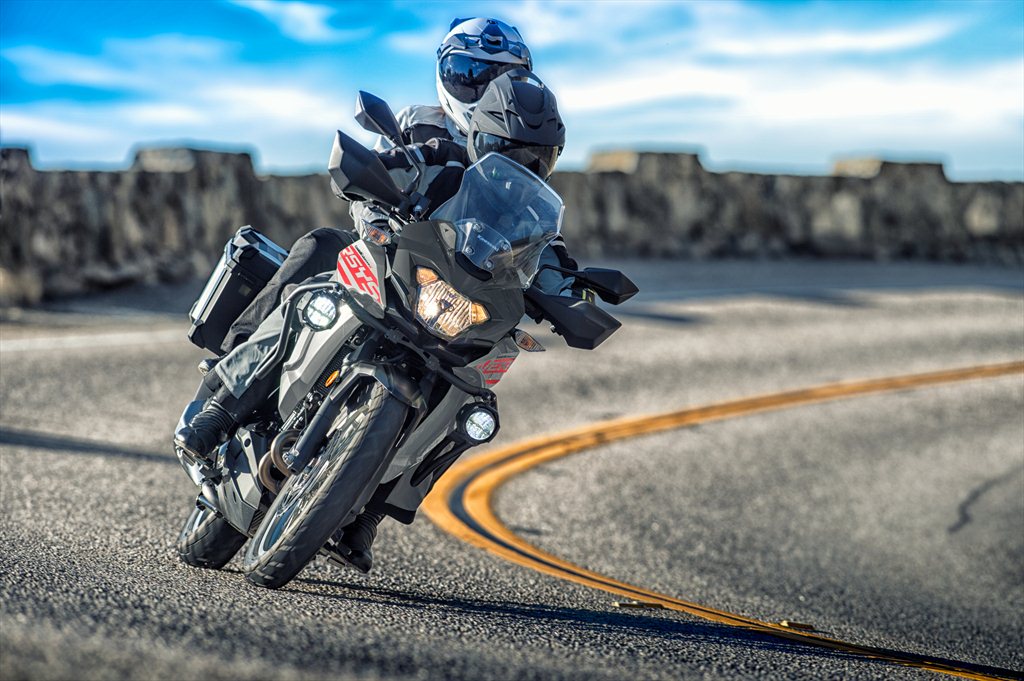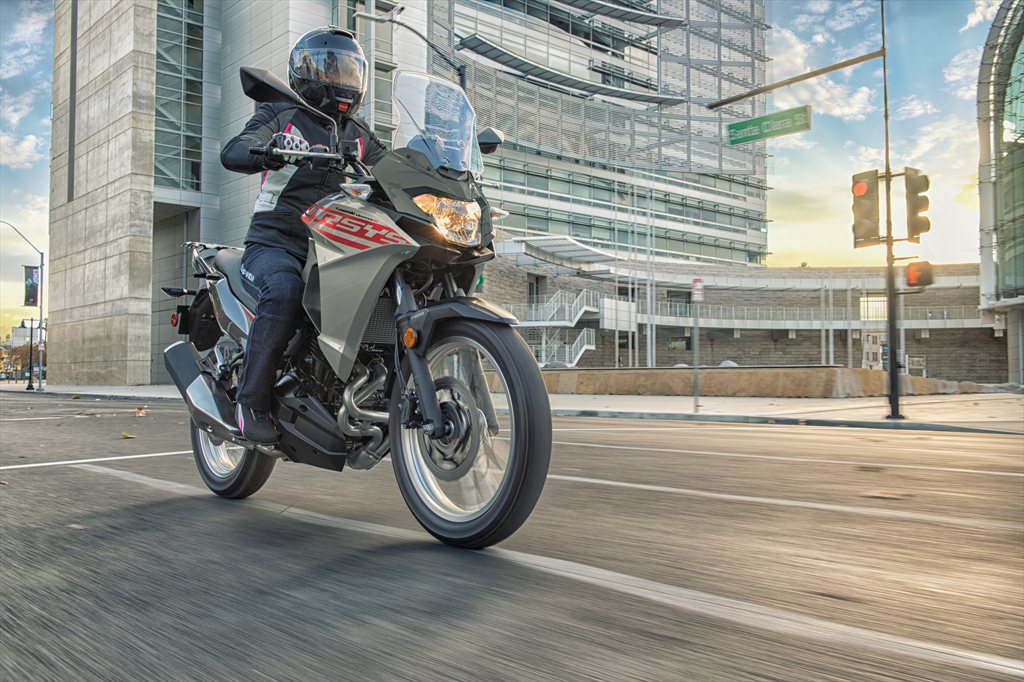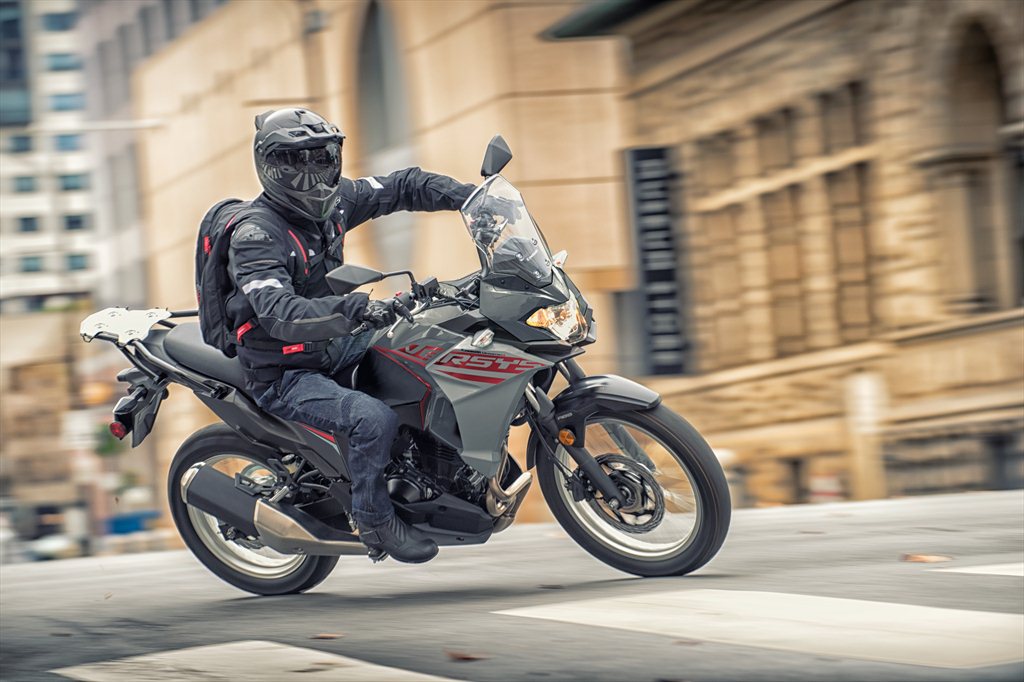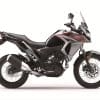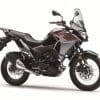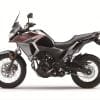The 2021 Kawasaki Versys-X 300: A Small Adventurer For City Fun
Contents
The Versys-X 300 is Kawasaki’s smallest adventure motorcycle in the 2021 lineup, designed mostly for city roads and maybe some gravel and dirt alleyways. More accurately an adventure tourer than an out-and-out adventure bike, and partially because most of Japan’s roads are paved, the Versys-X 300 is nonetheless a capable commuter and adventure motorcycle. Powered by a 296cc DOHC liquid cooled parallel twin, the Versys-X 300 produces 40 HP and 19 lb-ft of torque. While that may not sound like much, the entire bike weighs only 386 lbs wet.
Borrowing heavily from its larger engined brethren, the Versys-X 300 features a low seat height paired with a high front cowling and windshield. This is to both keep the rider as close to the center of balance on the bike, as well as to help the airflow coming off the windshield to fly over the helmet of the rider, reducing buffeting and wind noise. Optional handguards help keep your hands warm, and the Kawasaki-designed quick mount system is installed on the rear, allowing for your own pannier lockers, saddlebags, or Kawasaki hard luggage system to be installed.
The 2021 Kawasaki Versys-X 300 starts at $5,899 USD / $6,799 CAD.
On this page: we’ve curated specs, features, news, photos/videos, etc. so you can read up on the new 2021 Kawasaki Versys-X 300 in one place.
Model Overview
General Info
- Price: $5,899 USD / $6,799 CAD
- Key Features:
-
- Windscreen and front high cowl
- Dual-zone ABS
- Add-on options are extensive, from handguards to engine protectors
Main Specs
- Engine Type: 296cc, liquid-cooled, 4-stroke, DOHC 8-valve parallel twin
- Horsepower: 40 HP
- Torque: 19 lb-ft
- Wet Weight: 386 lbs (175 kg)
- Seat Height: 32.1 inches (815 mm)
Competitors
2021 Kawasaki Versys-X 300 Specifications
ENGINE |
||
| Engine | 296cc, liquid-cooled, 4-stroke, DOHC 8-valve parallel twin | |
| Power | 40 hp | |
| Bore x Stroke | 62.0 x 49.0mm | |
| Compression Ratio |
10.6:1
|
|
| Fuel System | DFI® with 32mm throttle bodies (2) | |
| Starter | Electric | |
| Lubrication | ||
DRIVETRAIN |
||
| Clutch | ||
| Transmission | 6-speed, return shift | |
| Final Drive | Sealed chain | |
CHASSIS |
||
| Suspension Front | Telescopic fork/5.1 in | |
| Suspension Rear | Uni-Trak® swingarm/5.8 in | |
| Brakes Front | Single disc, ABS | |
| Brakes Rear |
Single disc, ABS
|
|
| Tires Front | 100/90-19M/C 57S | |
| Tires Rear | 130/80-17M/C 65S | |
| Fuel Tank Capacity | 4.5 gal | |
| Color |
Metallic Graphite Gray/Metallic Spark Black
|
|
ELECTRICAL |
||
| Ignition | TCBI with digital advance | |
| Spark Plugs | ||
| Headlight | LED | |
| Tail Light | LED | |
DIMENSIONS |
||
| Overall Length | 85.4 in | |
| Overall Width | 33.9 in | |
| Overall Height | 54.7 in | |
| Wheelbase | 57.1 in | |
| Ground Clearance | 7.1 in | |
| Seat Height | 32.1 in | |
| Curb Weight | 385.9 lb | |
WARRANTY |
||
| Warranty | 12 Month Limited Warranty | |
| Kawasaki Protection Plus | 12 / 24 / 36 / 48 months | |
2021 Kawasaki Versys-X 300 Features
Assist & Slipper Clutch
Under normal operation, the assist cam functions as a self-servo mechanism, pulling the clutch hub and operating plate together to compress the clutch plates. This allows the total clutch spring load to be reduced, resulting in a lighter clutch lever feel when operating the clutch.
When excessive engine braking occurs – as a result of quick downshifts (or an accidental downshift) – the slipper cam comes into play, forcing the clutch hub and operating plate apart. This relieves pressure on the clutch plates to reduce back-torque and helps prevent the rear tire from hopping and skidding. This race-style function is particularly useful when sport or track riding.
Dual Throttle Valves
On models with dual throttle valves, there are two throttle valves per cylinder: in addition to the main valves, which are physically linked to the throttle grip and controlled by the rider, a second set of valves, opened and closed by the ECU, precisely regulates intake airflow to ensure a natural, linear response. With the air passing through the throttle bodies becoming smoother, combustion efficiency is improved and power is increased.
Economical Riding Indicator
While effective vehicle speed and engine speed may vary by model, paying attention to conditions that cause the “ECO” mark to appear can help riders improve their fuel efficiency – a handy way to increase cruising range. Further, keeping fuel consumption low also helps minimize negative impact on the environment.
ABS (Anti-lock Brake System)
ERGO-FIT®
ERGO-FIT® is an interface system designed to allow riders to find their ideal riding position. Various points of the chassis interface (the handlebar, footpegs and seat, etc.) can be adjusted through a combination of interchangeable parts and parts with adjustable positions. This enables a wide range of riders to find a riding position that offers both comfort and control. Feeling at one with their machine, they will be able to experience how Kawasaki machines are fun and rewarding to ride.
*Adjustable parts and their range of adjustability vary by model.
2021 Kawasaki Versys-X 300 Photos
2021 Kawasaki Versys-X 300 Videos
N/A
Links
Kawasaki Official Websites


